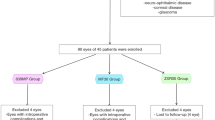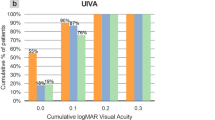Abstract
Purpose
To evaluate the tolerance for refractive errors and visual outcomes of extended depth of focus intraocular lens (EDOF IOLs) in patients with previous corneal refractive surgery for myopia.
Methods
Patients from Aier Eye Hospital of Wuhan University with previous myopia excimer laser correction underwent cataract surgery and implantation of an EDOF IOL. The follow-up period was three months. The uncorrected distance, intermediate, and near visual acuities (UDVA, UIVA, UNVA), corrected distance visual acuity (CDVA), spherical equivalent (SE), defocus curve, optical quality, including modulation transfer functions (MTF) and Strehl ratio (SR), National Eye Institute Visual Functioning Questionnaire-14 for Chinese people (VF-14-CN), spectacle independence, and dysphotopsia were assessed.
Results
At the final visit, UDVA, CDVA, UIVA, and UNVA (LogMAR) were 0.06 ± 0.09, 0.01 ± 0.06, 0.11 ± 0.08, 0.20 ± 0.10, respectively. The mean spherical equivalent (SE) was − 0.57 ± 0.58D, sphere and cylinder were − 0.24 ± 0.60D, − 0.70 ± 0.58D respectively. No statistical difference in UDVA between eyes with SE in ± 0.50 D and in ± 1.0 D (p > 0.05). Corneal astigmatism > 1.00D has no significant effect on postoperative visual acuity (p > 0.05). The defocus curve showed that visual acuity could reach 0.2 in the refractive range of + 0.50D ~ − 1.50D. SR and MTF values were all higher than before the surgery. In bilateral implantation patients, the VF-14-CN questionnaire score and visual quality were quite excellent.
Conclusion
The EDOF IOL have a certain tolerance for refractive errors and corneal astigmatism, and it’s recommended for patients with prior myopia excimer laser surgery to achieve satisfactory visual performance.



Similar content being viewed by others
Data availability
The datasets used and/or analyzed during the current study are available from the corresponding author on reasonable request.
Abbreviations
- IOL:
-
Intraocular lens
- EDOF IOL:
-
Extended depth of focus intraocular lens
- UDVA:
-
Uncorrected distance visual acuities
- UIVA:
-
Uncorrected intermediate visual acuities
- UNVA:
-
Uncorrected near visual acuities
- CDVA:
-
Corrected distance visual acuity
- SE:
-
Spherical equivalent
- MTF:
-
Modulation transfer functions
- SR:
-
Strehl’s ratio
- VF-14-CN:
-
Visual functioning questionnaire-14 for Chinese people
- LASIK:
-
Laser-assisted in situ keratomileusis
- HOAs:
-
Higher-order aberrations
- PD:
-
Pupil diameter
- AST:
-
Astigmatism
References
Iijima K, Kamiya K, Shimizu K, Igarashi A, Komatsu M (2015) Demographics of patients having cataract surgery after laser in situ keratomileusis. J Cataract Refract Surg 41(2):334–338. https://doi.org/10.1016/j.jcrs.2014.05.045
Vrijman V, van der Linden JW, van der Meulen I, Mourits MP, Lapid-Gortzak R (2018) Multifocal intraocular lens implantation after previous hyperopic corneal refractive laser surgery. J Cataract Refract Surg 44(4):466–470. https://doi.org/10.1016/j.jcrs.2018.01.030
Jorgensen A, Weber CH (2017) New intraocular lenses. Adv Ophthalmol Optom 2(1):167–176. https://doi.org/10.1016/j.yaoo.2017.05.001
Pantanelli SM, Lin CC, Al-Mohtaseb Z, Rose-Nussbaumer JR, Santhiago MR, Steigleman WA 3rd, Schallhorn JM (2021) Intraocular lens power calculation in eyes with previous excimer laser surgery for myopia: a report by the American academy of ophthalmology. Ophthalmology 128(5):781–792. https://doi.org/10.1016/j.ophtha.2020.10.031
Wang L, Koch DD (2021) Intraocular lens power calculations in eyes with previous corneal refractive surgery: review and expert opinion. Ophthalmology 128(11):e121–e131. https://doi.org/10.1016/j.ophtha.2020.06.054
Son HS, Kim SH, Auffarth GU, Choi CY (2019) Prospective comparative study of tolerance to refractive errors after implantation of extended depth of focus and monofocal intraocular lenses with identical aspheric platform in Korean population. BMC Ophthalmol 19(1):187. https://doi.org/10.1186/s12886-019-1193-z
Cochener B (2017) Tecnis symfony intraocular lens with a “sweet spot” for tolerance to postoperative residual refractive errors. Open J Ophthalmol 7:14–20. https://doi.org/10.4236/ojoph.2017.71003
Carones F (2017) residual astigmatism threshold and patient satisfaction with bifocal, trifocal and extended range of vision intraocular lenses (IOLs). Open J Ophthalmol 7:1–7. https://doi.org/10.4236/ojoph.2017.71001
Olson RJ, Braga-Mele R, Chen SH, Miller KM, Pineda R 2nd, Tweeten JP, Musch DC (2017) Cataract in the adult eye preferred practice pattern®. Ophthalmology 124(2):P1–P119. https://doi.org/10.1016/j.ophtha.2016.09.027
Haigis W (2008) Intraocular lens calculation after refractive surgery for myopia: Haigis-L formula. J Cataract Refract Surg 34(10):1658–1663. https://doi.org/10.1016/j.jcrs.2008.06.029
Abulafia A, Hill WE, Koch DD, Wang L, Barrett GD (2016) Accuracy of the Barrett True-K formula for intraocular lens power prediction after laser in situ keratomileusis or photorefractive keratectomy for myopia. J Cataract Refract Surg 42(3):363–369. https://doi.org/10.1016/j.jcrs.2015.11.039
Shammas HJ, Shammas MC (2007) No-history method of intraocular lens power calculation for cataract surgery after myopic laser in situ keratomileusis. J Cataract Refract Surg 33(1):31–36. https://doi.org/10.1016/j.jcrs.2006.08.045
Ribeiro FJ, Castanheira-Dinis A, Dias JM (2012) Personalized pseudophakic model for refractive assessment. PLoS ONE 7(10):e46780. https://doi.org/10.1371/journal.pone.0046780
Akella SS, Juthani VV (2018) Extended depth of focus intraocular lenses for presbyopia. Curr Opin Ophthalmol 29(4):318–322. https://doi.org/10.1097/ICU.0000000000000490
Ferreira TB, Pinheiro J, Zabala L, Ribeiro FJ (2018) Comparative analysis of clinical outcomes of a monofocal and an extended-range-of-vision intraocular lens in eyes with previous myopic laser in situ keratomileusis. J Cataract Refract Surg 44(2):149–155. https://doi.org/10.1016/j.jcrs.2017.11.007
Li QM, Wang F, Wu ZM, Liu Z, Zhan C, Chen BH, Sima J, Stieger K, Li SW (2020) Trifocal diffractive intraocular lens implantation in patients after previous corneal refractive laser surgery for myopia. BMC Ophthalmol 20(1):293. https://doi.org/10.1186/s12886-020-01556-0
Cochener B, Boutillier G, Lamard M, Auberger-Zagnoli C (2018) A comparative evaluation of a new generation of diffractive trifocal and extended depth of focus intraocular lenses. J Refract Surg 34(8):507–514. https://doi.org/10.3928/1081597X-20180530-02
Pedrotti E, Bruni E, Bonacci E, Badalamenti R, Mastropasqua R, Marchini G (2016) Comparative analysis of the clinical outcomes with a monofocal and an extended range of vision intraocular lens. J Refract Surg 32(7):436–442. https://doi.org/10.3928/1081597X-20160428-06
Ruiz-Mesa R, Abengózar-Vela A, Aramburu A, Ruiz-Santos M (2017) Comparison of visual outcomes after bilateral implantation of extended range of vision and trifocal intraocular lenses. Eur J Ophthalmol 27(4):460–465. https://doi.org/10.5301/ejo.5000935
Breyer D, Kaymak H, Ax T, Kretz F, Auffarth GU, Hagen PR (2017) Multifocal intraocular lenses and extended depth of focus intraocular lenses. Asia-Pac J Ophthalmol 6(4):339–349. https://doi.org/10.22608/APO.2017186
Escandón-García S, Ribeiro FJ, McAlinden C, Queirós A, González-Méijome JM (2018) Through-focus vision performance and light disturbances of 3 new intraocular lenses for presbyopia correction. J ophthalmol 2018:6165493. https://doi.org/10.1155/2018/6165493
Santhiago MR, Wilson SE, Netto MV, Ghanen RC, Monteiro ML, Bechara SJ, Espana EM, Mello GR, Kara N (2012) Modulation transfer function and optical quality after bilateral implantation of a +3.00 D versus a +4.00 D multifocal intraocular lens. J Cataract Refract Surg 38(2):215–220. https://doi.org/10.1016/j.jcrs.2011.08.029
Mencucci R, Favuzza E, Caporossi O, Savastano A, Rizzo S (2018) Comparative analysis of visual outcomes, reading skills, contrast sensitivity, and patient satisfaction with two models of trifocal diffractive intraocular lenses and an extended range of vision intraocular lens. Graefe’s Arch Clin Exp Ophthalmol (Albrecht von Graefes Archiv fur klinische und experimentelle Ophthalmologie) 256(10):1913–1922. https://doi.org/10.1007/s00417-018-4052-3
Pedrotti E, Carones F, Aiello F, Mastropasqua R, Bruni E, Bonacci E, Talli P, Nucci C, Mariotti C, Marchini G (2018) Comparative analysis of visual outcomes with 4 intraocular lenses: monofocal, multifocal, and extended range of vision. J Cataract Refract Surg 44(2):156–167. https://doi.org/10.1016/j.jcrs.2017.11.011
Koo OS, Kang JW, Park JK, Kim KH (2021) Visual performance and patient satisfaction after implantation of extended range-of-vision IOLs: bilateral implantation versus 2 different mix-and-match approaches. J Cataract Refract Surg 47(2):192–197. https://doi.org/10.1097/j.jcrs.0000000000000424
Pilger D, Homburg D, Brockmann T, Torun N, Bertelmann E, von Sonnleithner C (2018) Clinical outcome and higher order aberrations after bilateral implantation of an extended depth of focus intraocular lens. Eur J Ophthalmol 28(4):425–432. https://doi.org/10.1177/1120672118766809
Acknowledgements
Not Applicable.
Funding
The study was supported in part by Medical Research Projects of Wuhan Municipal Health Commission (Grant No. WX21A03), Science Research Foundation of Aier Eye Hospital Group (Grant No. AR2002D4), Science Research Foundation of Aier Eye Hospital Group (Grant No. AR2110D1).
Author information
Authors and Affiliations
Contributions
Hansong Zheng and Yong Wang conceived of and designed this study. Yong Wang performed the surgeries and contributed to the data acquisition. Hansong Zheng performed the patient follow-up and data collection, the data analysis and rechecking, and drafted the initial manuscript. Qian Tan, Suowang Zhou, Wenjing Luo, Julio Ortega-Usobiaga, Li Wang, and Yong Wang revised the manuscript critically for important intellectual content. This manuscript has been read and approved by all the authors, and each author believes that the manuscript represents honest work.
Corresponding author
Ethics declarations
Competing interests
The authors declare no competing interests.
Ethical approval
The study was approved by the Institutional Review Board of Aier Eye Hospital of Wuhan University (ID:2021IRBKY1011). All enrolled patients were treated in accordance with the tenets of the Declaration of Helsinki. Due to the retrospective nature of the study,the need for informed consent was waived by the Institutional Review Board of Aier Eye Hospital of Wuhan University.
Consent for publication
Not applicable.
Additional information
Publisher's Note
Springer Nature remains neutral with regard to jurisdictional claims in published maps and institutional affiliations.
Rights and permissions
Springer Nature or its licensor (e.g. a society or other partner) holds exclusive rights to this article under a publishing agreement with the author(s) or other rightsholder(s); author self-archiving of the accepted manuscript version of this article is solely governed by the terms of such publishing agreement and applicable law.
About this article
Cite this article
Zheng, H., Tan, Q., Zhou, S. et al. The tolerance of refractive errors of extended depth of focus intraocular lens in patients with previous corneal refractive surgery. Int Ophthalmol 43, 3989–3997 (2023). https://doi.org/10.1007/s10792-023-02802-2
Received:
Accepted:
Published:
Issue Date:
DOI: https://doi.org/10.1007/s10792-023-02802-2




